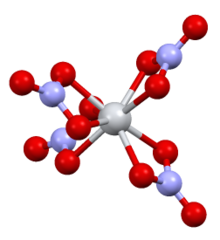 Ball-and-stick model | |
| Names | |
|---|---|
| Other names titanium tetranitrate, tetranitratotitanium | |
| Identifiers | |
| CAS Number | |
| 3D model (JSmol) | |
| ChemSpider | |
| ECHA InfoCard | 100.222.601 |
| PubChem CID | |
| CompTox Dashboard (EPA) | |
InChI
| |
SMILES
| |
| Properties | |
| Chemical formula | Ti(NO3)4 |
| Molar mass | 295.8866 g/mol |
| Appearance | white volatile solid |
| Density | 2.192 |
| Melting point | 58 °C (136 °F; 331 K) |
| Boiling point | decompose |
| Solubility in water | Reacts |
| Structure | |
| Crystal structure | monoclinic |
| Space group | P21/C |
| Lattice constant | a = 7.80, b = 13.57, c = 10.34 Åα = 90°, β = 125·0°, γ = 90° |
| Lattice volume (V) | 896.52 Å |
| Formula units (Z) | 4 |
| Coordination geometry | 8 |
| Molecular shape | flattened tetrahedral |
| Related compounds | |
| Related compounds | hafnium nitrate, zirconium nitrate, titanium phosphate, titanium perchlorate |
| Except where otherwise noted, data are given for materials in their standard state (at 25 °C , 100 kPa). Infobox references | |
Titanium nitrate is the inorganic compound with formula Ti(NO3)4. It is a colorless, diamagnetic solid that sublimes readily. It is an unusual example of a volatile binary transition metal nitrate. Ill defined species called titanium nitrate are produced upon dissolution of titanium or its oxides in nitric acid.
Preparation
Similarly to its original method, Ti(NO3)4 is prepared by the nitration of titanium tetrachloride using dinitrogen pentoxide or chlorine nitrate:
- TiCl4 + 4 N2O5 → Ti(NO3)4 + 4 ClNO2
Hydrated titanium nitrate, the nitrate salt of the aquo complex , is produced upon dissolution of titanium compounds in nitric acid.
Structure
The complex has D2d symmetry, with four bidentate nitrate ligands. The N-O distances are 1·29 Å and 1·185 Å (noncoordinated).
Physical properties
In the infrared spectrum, it absorbs strongly at 1635 cm, assigned to a N-O vibrational mode.
It is soluble in nonpolar solvents silicon tetrachloride and carbon tetrachloride.
Reactions
Titanium nitrate is hygroscopic, converting to ill-defined hydrates. The anhydrous material is highly reactive, even toward hydrocarbons. Titanium nitrate also reacts with n-dodecane, p-dichlorobenzene, anisole, biphenyl,
It decomposes thermally to titanium dioxide.
References
- Garner, C. D.; Wallwork, S. C. (1966). "The crystal structures of anhydrous nitrates and their complexes. Part III. Titanium(IV) nitrate". J. Chem. Soc. A: 1496–1500. doi:10.1039/J19660001496.
- "ICSD 26639 : ICSD Structure : N4 O12 Ti". Cambridge Structural Database: Access Structures. Cambridge Crystallographic Data Centre. Retrieved 2021-05-08.
- "Titanium(iv) nitrate (Ti(NO3)4)". Retrieved 27 September 2014.
- Chemistry of the Elements (Second Edition). N. N. Greenwood and A. Earnshaw. P966. 21.3.4 Compounds with oxoanions
- Nathaniel Howell Furman; R. J. Mundy; G. H. Morrison (1955). The Distribution of Uranyl Nitrate from Aqueous Solutions to Diethyl Ether. the University of Michigan: U.S. Atomic Energy Commission. Technical Information Service. p. 51.
- ^ Garner, C. David; Ian H. Hillier; Martyn F. Guest (1975). "Ab initio self-consistent field molecular-orbital calculation of the ground state of tetranitratotitanium(IV); comments on the reactivity of anhydrous metal nitrates". Journal of the Chemical Society, Dalton Transactions (19): 1934. doi:10.1039/DT9750001934. ISSN 0300-9246.
- Reihlen, Hans; Andreas Hake (1927). "Über die Konstitution des N2O4 und N2O3 und die Additionsverbindungen von Nitro- und Nitrosokörpern an Zinn- und Titantetrachlorid". Justus Liebig's Annalen der Chemie (in German). 452 (1): 47–67. doi:10.1002/jlac.19274520104. ISSN 0075-4617.
- ^ Schmeisser, Martin (1955). "Die Chemie der anorganischen Acylnitrate (ein Problem des Nitrylchlorids) und Acylperchlorate (ein Problem des Dichlorhexoxyds)". Angewandte Chemie (in German). 67 (17–18): 493–501. Bibcode:1955AngCh..67..493S. doi:10.1002/ange.19550671708. ISSN 0044-8249.
- P. Ehrlich "Titanium Tetranitrate" in Handbook of Preparative Inorganic Chemistry, 2nd Ed. Edited by G. Brauer, Academic Press, 1963, NY. Vol. 1. p. 1237.
- Schmeisser, M.; Brandle, K. Acyl nitrates and perchlorates. IV. ClNO3 as starting material for acyl nitrates. Angewandte Chemie, 1957. 69: 781. ISSN: 0044-8249.
- Wiberg, Egon; Wiberg, Nils (2001). Inorganic Chemistry. Academic Press. p. 1331. ISBN 9780123526519. Retrieved 28 September 2014.
- Addison, C. C.; Logan, N.; Wallwork, S. C.; Garner, C. D. (1971). "Structural Aspects of Co-ordinated Nitrate Groups". Quarterly Reviews, Chemical Society. 25 (2): 289. doi:10.1039/qr9712500289.
- Amos, D.W.; G.W. Flewett (1974). "Raman spectra of titanium (IV) and tin (IV) nitrates". Spectrochimica Acta Part A: Molecular Spectroscopy. 30 (2): 453–461. Bibcode:1974AcSpA..30..453A. doi:10.1016/0584-8539(74)80085-1. ISSN 0584-8539.
- ^ Amos, D.W.; D.A. Baines, G.W. Flewett (1973). "Nitration by titanium (IV) nitrate". Tetrahedron Letters. 14 (34): 3191–3194. doi:10.1016/S0040-4039(00)79808-X. ISSN 0040-4039.
- ^ Coombes, Robert G.; Leslie W. Russell (1974). "Nitration of aromatic compounds by tetranitratotitanium(IV) in carbon tetrachloride solution". Journal of the Chemical Society, Perkin Transactions 2 (7): 830. doi:10.1039/P29740000830. ISSN 0300-9580.
- Schofield, Kenneth (1980). Aromatic Nitration. CUP Archive. pp. 97–98. ISBN 9780521233620. Retrieved 27 September 2014.
- Allendorf, Mark Donald (1999-01-01). "Titanium Oxide CVD from Titanium (IV) Nitrate ...". Proceedings of the Symposium on Fundamental Gas-Phase and Surface Chemistry of Vapor-Phase Materials Synthesis. The Electrochemical Society. pp. 395–397. ISBN 9781566772174. Retrieved 27 September 2014.
Other reading
- Partington, J. R.; A. L. Whynes (1949). "660. Reactions of nitrosyl chloride. Part II". Journal of the Chemical Society (Resumed): 3135. doi:10.1039/JR9490003135. ISSN 0368-1769.
- Dauerman, L.; G.E. Salser (1973). "Mass spectra of covalent inorganic nitrates: copper(II) nitrate and titanium(IV) nitrate". Journal of Inorganic and Nuclear Chemistry. 35 (1): 304–306. doi:10.1016/0022-1902(73)80643-8. ISSN 0022-1902.
| Titanium compounds | |||||
|---|---|---|---|---|---|
| Titanium(II) |
| ||||
| Titanium(III) |
| ||||
| Titanium(IV) |
| ||||
| Salts and covalent derivatives of the nitrate ion | ||||||||||||||||||||||||||||||||||||||||||||||||||||||||||||||||||||||||||||||||||||||||||||||||||||||||||||||||||||||||||||||||||||||||||||||||||||||||||||||||||||
|---|---|---|---|---|---|---|---|---|---|---|---|---|---|---|---|---|---|---|---|---|---|---|---|---|---|---|---|---|---|---|---|---|---|---|---|---|---|---|---|---|---|---|---|---|---|---|---|---|---|---|---|---|---|---|---|---|---|---|---|---|---|---|---|---|---|---|---|---|---|---|---|---|---|---|---|---|---|---|---|---|---|---|---|---|---|---|---|---|---|---|---|---|---|---|---|---|---|---|---|---|---|---|---|---|---|---|---|---|---|---|---|---|---|---|---|---|---|---|---|---|---|---|---|---|---|---|---|---|---|---|---|---|---|---|---|---|---|---|---|---|---|---|---|---|---|---|---|---|---|---|---|---|---|---|---|---|---|---|---|---|---|---|---|---|
| ||||||||||||||||||||||||||||||||||||||||||||||||||||||||||||||||||||||||||||||||||||||||||||||||||||||||||||||||||||||||||||||||||||||||||||||||||||||||||||||||||||